ABSTRACT
Groundnut is important as an edible oil and food crop in Myanmar. Thousands of smallholder farmers in Myanmar grow groundnut for household food consumption and earning. Sagaing Region occupied the largest groundnut sown area in Myanmar. This study was done to analyze value added processing opportunities and profit function of groundnut farmers in the study area. A total of 150 groundnut farmers were interviewed by using purposive random sampling method with structured questionnaires in Myinmu Township, Sagaing Region in 2018. Descriptive, cost and return and regression analyses were used. The findings indicated that the groundnut profit was positively and significantly influenced by groundnut yield, while family labor cost, hired labor cost and total material cost were negatively and significantly influenced on profit of groundnut production. The profit of highly purified grain, total material cost, family labor cost and hired labor cost were negatively and significantly influenced, and price and processing cost were positively and significantly influenced. The profit of low purified grain, total material cost and family labor cost were negatively and significantly influenced, and price and processing cost were positively and significantly influenced. Based on the findings, seed and highly purified grain production were economically more attractive for farmers than other groundnut products. It would be concluded that, groundnut farmers can earn more profit by selling of value added groundnut products. Therefore, groundnut value added enterprise would be required to encourage for improving the socio-economic conditions of farmers.
Keywords: Groundnut, Value Added, Profitability, Myinmu Township, Sagaing Region, Myanmar.
INTRODUCTION
In Myanmar, cereals, oilseeds, pulses, industrial and culinary crops are principally cultivated not only for consumption but also for household earnings. Among these crops, cereal crops had the largest sown area and culinary crops had the smallest one in 2017-2018 as shown in Figure 1 (Ministry of Agriculture, Livestock and Irrigation (MOALI), 2018).
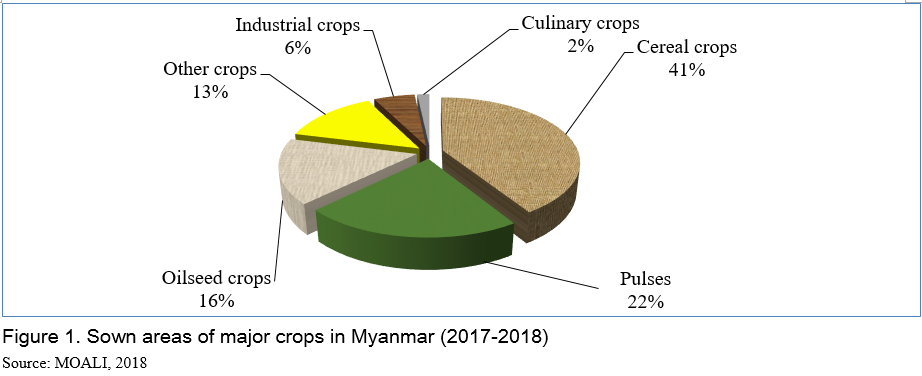
Major oilseed crops include groundnut, sesame, sunflower, mustard, niger and oil palm. They also play a vital role due to a high consumption of cooking oil compared to neighboring countries. As the amount of edible oil produced is not sufficient for local consumption, approximately 200,000 metric tons of palm oil is imported annually to meet local requirement. In order to reduce the imported palm oil, efforts to increase yield and production of oilseed crops such as use of high yielding varieties and hybrid seeds, modern cultural practices and practicing an appropriate cropping pattern are implemented. In upland farming system, hybrid sunflower seeds have been introduced in appropriate areas to double the existing average yield. Among the oilseed crops, groundnut is one of the most popular edible oil and protein producing crops in the world. Most of the groundnut grown in the world is to produce oil, groundnut butter, confectionaries, roasted groundnuts and snack products, extenders in meat product formulations, soups and desserts. Groundnut is directly consumed as raw nut or in processed form based on the different value chains (Dhanesh and Kochhar, 2015).
Groundnut cultivation occupies the second largest areas with the highest production among the oilseed crops in Myanmar (Figure 2). Sagaing Region has the largest sown area of groundnut in Myanmar. And also, Myinmu Township is the largest sown area of groundnut in Sagaing District. It is seen that most of the farmers selling raw products of groundnut received considerable low level of income. It is imperative to analyze value added processing opportunities for groundnut farmers to improve income level of groundnut production. Therefore, this study was conducted to analyze value added processing opportunities and profit function of groundnut farmers in Myinmu Township, Sagaing Region.
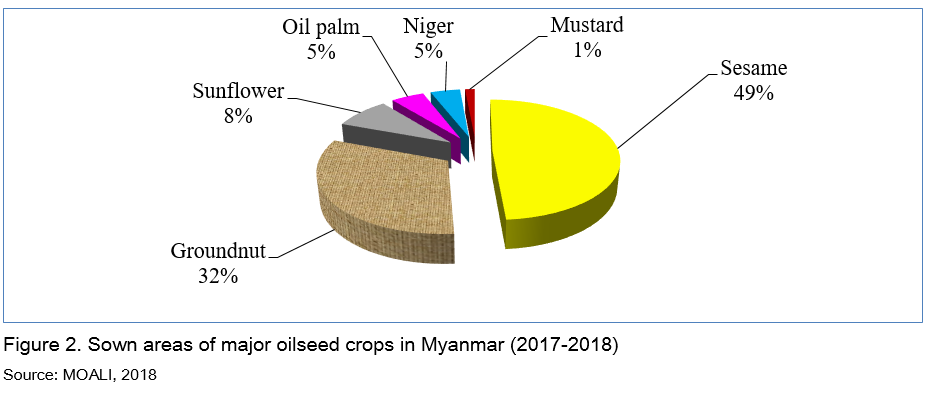
Research methodology
This study was carried out during the crop season of 2017-18 for the investigation of production and marketing activities for groundnut. Both primary and secondary data were used. Primary data was collected from individual households by using structured questionnaires. Field survey was done from November to December in 2018. A total of 150 sample farmers were selected from three sample villages by using purposive random sampling method. Both qualitative and quantitative data were firstly compiled in the Microsoft Excel program. Descriptive analysis, cost and return analysis and regression analysis were used with the help of statistical software packages, SPSS Version 25.0 in this study. To identify the influencing factors on profitability of groundnut production (pod), low purified grain and highly purified grain at farm level in the study areas, a regression function and a log linear regression function were used. The regression function was as follows;
Yi = β0+ β1X1i+ β2X2i+ β3X3i+ β4X4i+ b1D1i+b2 D2i+b3D3i + μi
Where;
Yi = Groundnut profit ('000 MMK/ha)
X1i = Yield of groundnut (kg/ha)
X2i = Total material cost ('000 MMK/ha)
X3i = Family labor cost ('000 MMK/ha)
X4i = Hired labor cost ('000 MMK/ha)
D1i = Climate change awareness (dummy variables, yes = 1, no = 0)
D2i = Access to credit (dummy variables, yes = 1, no = 0)
D3i = Market distance (dummy variables, Monywa and Mandalay wholesalers = 1, Myinmu wholesalers = 0)
βi, bi = Regression coefficients
ui = Disturbance term
i = 1…n
A log linear regression function was as follows;
LnYi = β0+Lnβ1X1i+Lnβ2X2i+Lnβ3X3i+Lnβ4X4i+Lnβ5X5i+Lnβ6X6i+Lnβ7X7i+Lnβ8X8i +b1D1i+b2D2i+ μi
Where;
LnYi = Log of groundnut profit (highly purified grain, low purified grain)
LnX1i = Log of price (highly purified grain and low purified grain)
LnX2i = Log of sown areas of groundnut
LnX3i = Log of total material cost
LnX4i = Log of family labor cost
LnX5i = Log of hired labor cost
LnX6i = Log of schooling years of sample farmer
LnX7i = Log of age of sample farmer
LnX8i = Log of processing cost
D1i = Access to credit (dummy variables, yes = 1, no = 0)
D2i = Market distance (dummy variables, Monywa and Mandalay wholesalers = 1, Myinmu wholesalers = 0)
βi, bi = Regression coefficients
ui = Disturbance term
i = 1…n
RESULTS AND DISCUSSION
Socio-economic characteristics of sample groundnut farmers
Socio-economic characteristics of sample groundnut farmers were presented in Table 1. In the study area, the average age of sample farmers was 56 years, 7 years of schooling years and 33 years of farming experience on average. The production of groundnut mainly depends on the land holding size. In the study area, the average land holding size was 7.90 hectares. The maximum and minimum of total land holding size were 30.35 hectares and 0.40 hectare. The average groundnut sown area of sample farmers was 1.40 hectares. And, the maximum and minimum of total groundnut sown areas were 8.09 hectares and 0.32 hectare. The average yield with shell (pod) of total groundnut sown areas was about 1.58 metric tons. The maximum and minimum yields with shell (pod) of total groundnut sown areas were about 11.34 metric tons and 0.23 metric ton (Table 2).


Markets destination of groundnut in the study area
In the study area, 54.00% and 15.33% of sample groundnut farmers sold highly purified grain or low purified grain (which was obtained after hulling groundnut with shell (pod)) to wholesalers in Monywa and Mandalay Townships (Table 3). In these areas, there are demands for both highly purified grain and low purified grain and these two types were bought by the same wholesaler (Monywa or Mandalay Townships). In addition, 16.00% of sample groundnut farmers sold seed or edible oil or oilcake to consumers in village. Then, highly purified grain or low purified grain was sold to wholesalers in Myinmu Township by 6.67% of sample groundnut farmers. Moreover, each 0.67% of sample groundnut farmers sold edible oil to consumers in Yangon and Pyin Oo Lwin.

Sources of credit availability among sample groundnut farmers were shown in Table 4. Most of sample groundnut farmers (79.33%) received credit only from Myanmar Agricultural Development Bank (MADB) and 8.67% of sample groundnut farmers received credit from Cooperative. And, 4.67% of sample groundnut farmers received credit from local money lenders. Then, each 0.67% of sample groundnut farmers received credit from United Nation Development Program (UNDP) and World Vision.
Credit amount and interest rate of sample farmers were described in Table 4. The sample groundnut farmers borrowed the average credit amount, 489,076 MMK/year (339.46 US$) from MADB by the interest rate 0.08% per year and 250,000 MMK/year (173.52 US$) from Cooperative by the interest rate of 0.18% per year, respectively. The average credit amount 285,714 MMK/year (198.31 US$) from local money lenders by the interest rate of 0.38% per year, 500,000 MMK/year (347 US$) from UNDP by the interest rate of 0.24% per year and 300,000 MMK/year (208.83 US$) from World Vision by the interest rate of 0.18% per year, respectively.
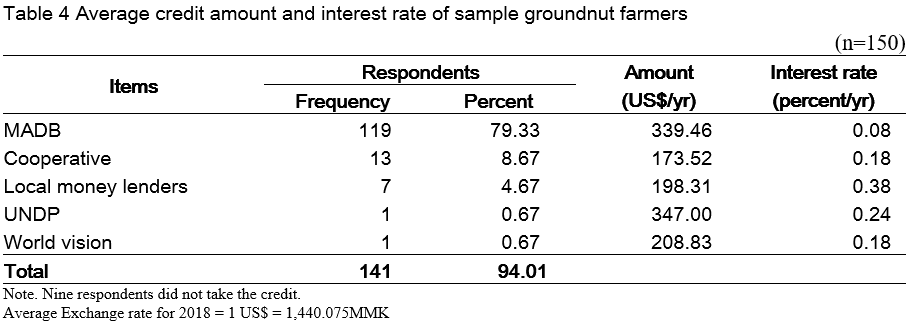
Cost and return analysis of groundnut production in the crop season
In this study, enterprise budget was calculated to analyze cost and return of groundnut production in Myinmu Township. Cost and return analysis of groundnut production for raw product and value added groundnut products was presented in Table 5.
Total variable cost of production included material input costs, hired labor costs, opportunities costs for family labor, interest on cash cost and marketing cost. Material input costs included the costs for seed, insecticides, fungicides, herbicides, compound, urea, gypsum, farm yard manure (FYM) and foliar fertilizers. Family labor costs and hired labor costs included the costs for ploughing, harrowing, sowing, thinning, intercultivation, insecticide application, fertilizer application, harvesting, transportation and drying. Interest on cash cost consisted of interest rate on material cost and hired labor cost. Total marketing cost included the costs for hulling, labor, packaging and transportation. Return of groundnut production included the yield per hectare, return from sale with average current price of groundnut during that period.
In this calculation, the benefit cost ratio (BCR) of pod, low purified grain and highly purified grain were 1, 1.30 and 1.43 respectively. And, the BCRs of edible oil and oilcake, and seed were 1.52 and 1.97. Among them, the smallest BCR was 1 from selling as pod (Table 5). It indicated that the return per unit capital invested was 0. It can be concluded that total variable cost of groundnut production of farmers was equal to return above variable cost of pod, because it was sold as a raw product without transaction to value added product and lower yield in the study period than other period. In addition, it was seen that seed obtained the largest BCR (1.97). It pointed out that return per unit capital invested was 0.97 after all.
INFLUENCING FACTORS ON PROFITABILITY OF DIFFERENT FORMS OF MARKET DEMAND FOR GROUNDNUT
This section indicated the estimate results of factors affecting the groundnut profit of the selected sample groundnut farmers in the study area. To identify the determinant factors on profitability of groundnut production, a linear regression function was used. The specific profit function of sample groundnut farmers was estimated by using 7 independent variables; yield (pod), total material cost, family labor cost, hired labor cost, climate change awareness, market distance and access to credit. The descriptive statistics of dependent and independent variables of groundnut profit function were shown in Table 6. Dummy variables of climate change awareness (1 = yes, 0 = no), access to credit (1 = yes, 0 = no) and market distance (1 = Monywa and Mandalay wholesalers, 0 = Myinmu wholesalers) were also included.
According to the groundnut profit regression estimates, groundnut profit of the sample farmers was positively and significantly influenced by yield at 1%. It indicated that the groundnut profit would be increased by MMK 780 (US$ 0.54) if one kilogram was increased in yield (pod) of groundnut. The results showed that the farmers who had got the highest yield can receive more profit because yield greatly affected on profit. The groundnut profit was negatively and significantly influenced by hired labor costs, family labor cost and total material cost on groundnut production at 1% level respectively. It can be concluded that the groundnut profit would be decreased by MMK 957 (US$ 0.66), MMK 981 (US$ 0.68) and MMK 923 (US$ 0.64) respectively if one thousand kyat (US$ 0.69) was increased in hired labor cost, family labor cost and total material cost. It pointed out that the farmers who had suffered high cost of hired labor cost, family labor cost and total material cost on the farm in groundnut production can receive low profit. The F-value pointed out that the model is highly significant as shown in Table 7.
To identify the determinant factors on profitability of low purified grain, a log linear regression function was used. The specific profit function of low purified grain was estimated by using 10 independent variables; price, total material cost, family labor cost, hired labor cost, sown areas of groundnut, age of sample farmer, schooling years of sample farmer, processing cost, market distance and access to credit. The descriptive statistics of dependent and independent variables of profit function for value added groundnut product (low purified grain) were shown in Table (8). Dummy variables of access to credit (1 = yes, 0 = no) and market distance (1= yes, 0 = no) were also included.
According to profit regression for value added groundnut product (low purified grain) estimates, profitability of low purified grain was positively and significantly influenced by price and processing cost for value added product at 5% and 1% levels, respectively. It means that farmers could receive the profit 5.86% and 3.99% if 1% was increased in price and processing cost on value added groundnut product (low purified grain). Farmers who had received high price and invested high cost obviously dominated on profit. And, total material cost and family labor cost were negatively and significantly influenced on profitability of value added groundnut product (low purified grain) at 5% level. The results showed that the farmers could decrease the profit by 2.24% and 0.90% if 1% was invested in total material cost and family labor cost on value added groundnut product (low purified grain). The F-value pointed out that the model is significant as presented in Table 9.
Determinants of the profitability of value added groundnut product (highly purified grain) of sample farmers
The regression results on factors influencing the profitability of value added groundnut product (highly purified grain) in Myinmu Township was shown in Table (10). To identify the determinant factors on profitability of highly purified grain, a log linear regression function was used. The specific profit function of highly purified grain was estimated by using 10 independent variables; price of highly purified grain, total material cost, family labor cost, hired labor cost, sown areas of groundnut, age sample farmer, schooling years of sample farmer, processing cost, market distance and access to credit. The descriptive statistics of dependent and independent variables of profit function for value added groundnut product were shown in Table 10. Dummy variables of access to credit (1 = yes, 0 = no), and market distance (1 = Monywa and Mandalay wholesalers, 0 = Myinmu wholesalers) were also included.
According to the regression results for highly purified grain estimates; profit of highly purified grain was positively and significantly influenced by price and processing cost at 1% level. It means that the profit would be increased by 1.59% and 1.63% if 1% was increased in price and processing cost of highly purified grain. The results showed that the farmers who had invested the highest cost and increased the price can earn more the profit because processing cost and price greatly affected on profit. In regression analysis, the groundnut profit was negatively and significantly influenced by family labor cost, total material cost and hired labor cost on highly purified grain production at 1% level. The results showed that the profit would be decreased by 0.32%, 0.38% and 0.36% respectively if one percent was increased in family labor cost, total material cost and hired labor cost on groundnut production. It indicated that the farmers who had used highest cost of family labor cost, hired labor cost and total material cost on the farm in highly purified grain production could decrease the profit. The F-value pointed out that the model is highly significant as indicated in Table 11.

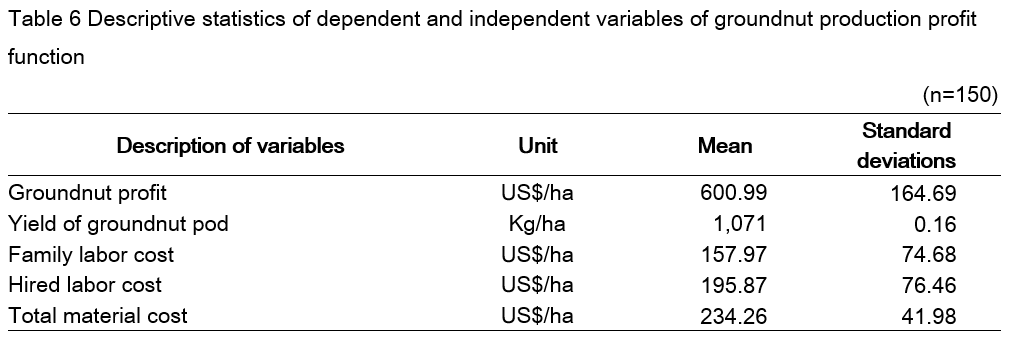
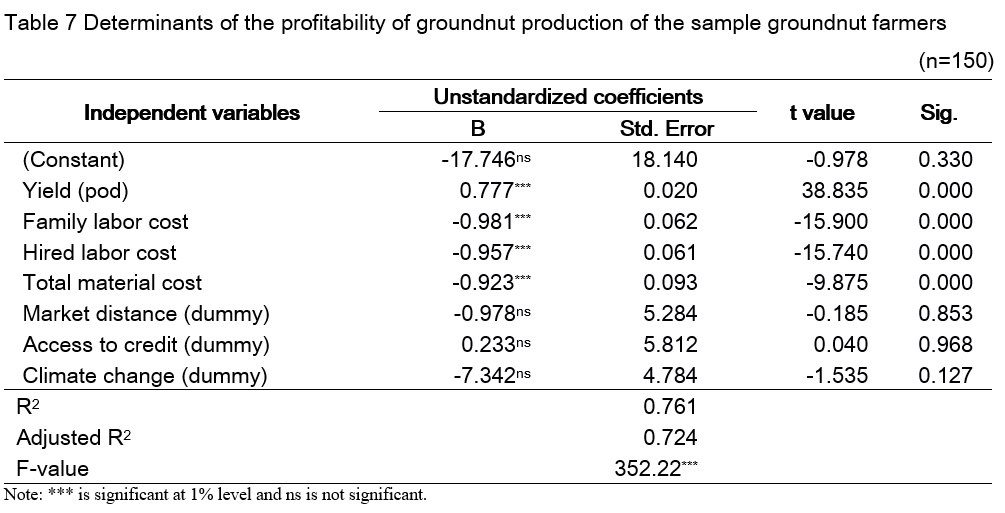

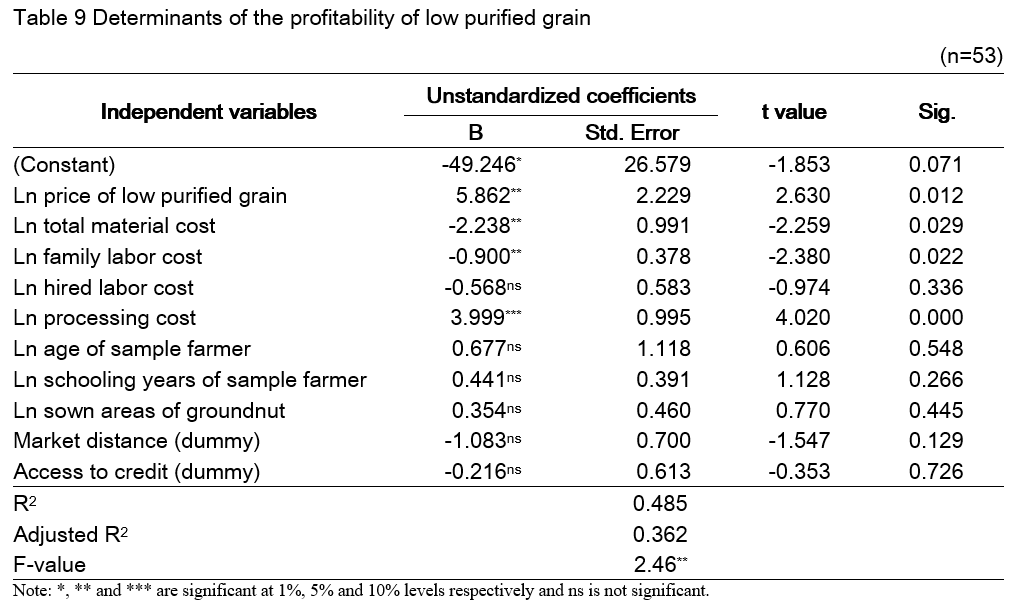

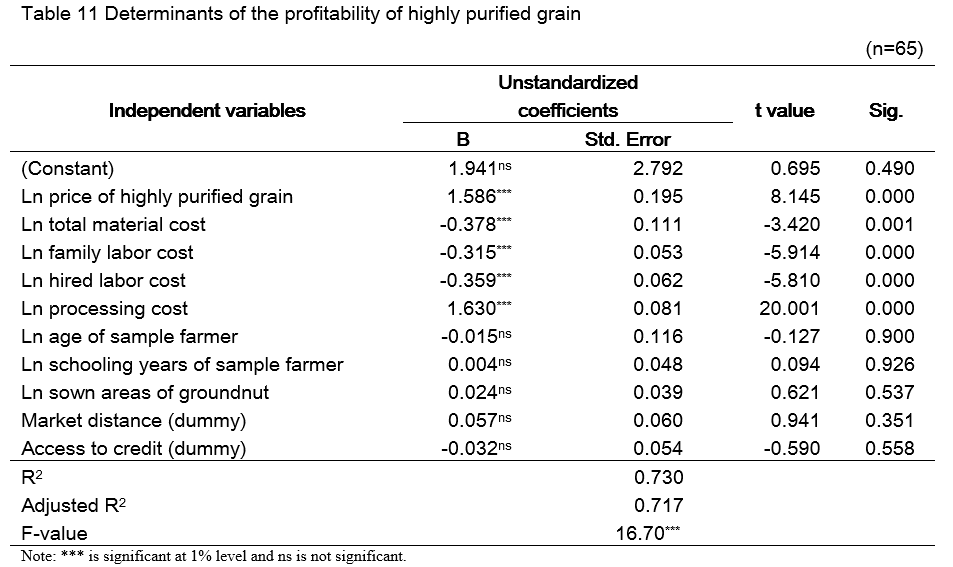
Most of sample farmers (94%) answered that they faced the effects of climate change in their crop production. Therefore, the average yield of groundnut was lower than the national target yield (1.68 MT/ha) because most sample groundnut farmers have faced the effects of climate change such as lower precipitation and others constraint in 2017-18. Moreover, the common constraints faced by sample farmers were labor scarcity, incidence of diseases and pests, high input cost, unstable price of output, lack of sufficient capital, water scarcity, lack of improved varieties, lack of extension service, high transportation cost and high production cost (Figure 3). These constraints limited farmers by reducing yield, unstable price & less profit.
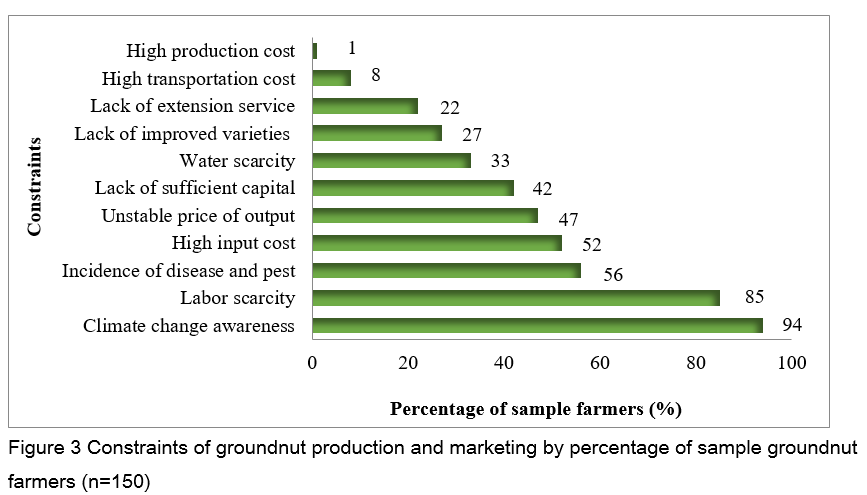
Policy implication
This study was an attempt to analyze value added processing opportunities and profit function of groundnut farmers in Myanmar. In the study area, most sample groundnut farmers were aged ones and they had a lot of farming experience in groundnut production. Majority of sample groundnut farmers had received secondary education. This indicated that they had more productive experiences and better potential for decision making in groundnut production. The average land holding capacity was a larger size in sample groundnut farmers. The average groundnut sown area was one fourth of their total land holding size. The average yield of groundnut (1.58 MT/ha) was lower than the national target yield (1.68 MT/ha) because sample groundnut farmers faced unfavorable effects of climate change such as lower precipitation in 2017-18. In the study area, low purified grain, highly purified grain, edible oil and oilcake, and seed were mainly sold by sample groundnut farmers as value added groundnut products. Therefore, effective extension program should be scaling up for agro-processing to improve processing opportunities at farm level. In this context, technical and financial supports would be definitely required.
The constraint analysis pointed out that 94 % of sample groundnut farmers faced climate change awareness such as lower precipitation and water scarcity. According to the insufficient water for cultivation, farmers cannot grow the crops in every season and face limited cultivation. The availability of adequate water resources for agriculture is essential for increased production. In addition, sources of credit should be supported to farmers that allocate their credits for farming activities in groundnut production. To obtain the maximum profit and income for the sample farmers, it was required to reduce the total production cost by using farm machinery in the study area.
According to the cost and return analysis, benefit cost ratio of seed was the higher than other groundnut product in the crop season. Therefore, seed production was economically more attractive to farmers in the study area. As a result of the marketing cost and marketing margin analysis of the raw product (pod), and value added groundnut product, seed got the higher percent of profit per cost price than the others. The results showed that groundnut farmers should consider on value added products of groundnut instead of selling raw product to earn more profit.
The result of regression analysis pointed out that groundnut yield was the most effective variable for groundnut profit. So, improved high yield variety is a necessary condition for the development in yield per unit area of groundnut production. Nowadays, sample groundnut farmers are still using local varieties because they easily received the seeds by reserving from their farm using traditional method. It means that the poor quality of the seeds decreased the yield and consequently, it reduces the income and return of the sample groundnut farmers. It can be concluded that it is immediately needed to develop seed industry through public private partnership and farmers’ effort themselves to meet the increasing demand for quality seed.
The groundnut yield was the most effective variables for groundnut profit which can increase farm income. The results showed that groundnut price was the most effective variable for income, better macro environment is necessary to increase crop price which can increase farm income. As for the total material cost, family labor and hired labor cost negatively influenced the profit of groundnut production, favorable policy environment for production and marketing of groundnut sector will be appreciated for the development of small farmers. In regression analysis, price and processing cost were the most effective variables for value added groundnut products which can increase farm income. As price and processing cost positively influenced the profit of value added groundnut products, value adding is a potential business for better income and profit of groundnut farmers. Therefore, groundnut value added enterprise would be required to encourage for improving the socio-economic conditions of farmers.
REFERENCES
Ministry of Agriculture, Livestock and Irrigation (MOALI). (2018). Myanmar Agriculture at a Glance, Department of Planning.
Ministry of Agriculture, Livestock and Irrigation (MOALI). (2018). Myanmar Agriculture in Brief, Department of Planning.
Dhanesh, B. T., & Kochhar, A. (2015). Peanut processing and its potential food applications. International Journal of Science and Research (IJSR). Vol. 4. 6. 6 (1). 2319-7064.



Factors Influencing on Profitability of Groundnut Production and Value Added Groundnut Products in Myinmu Township, Sagaing Region, Myanmar
ABSTRACT
Groundnut is important as an edible oil and food crop in Myanmar. Thousands of smallholder farmers in Myanmar grow groundnut for household food consumption and earning. Sagaing Region occupied the largest groundnut sown area in Myanmar. This study was done to analyze value added processing opportunities and profit function of groundnut farmers in the study area. A total of 150 groundnut farmers were interviewed by using purposive random sampling method with structured questionnaires in Myinmu Township, Sagaing Region in 2018. Descriptive, cost and return and regression analyses were used. The findings indicated that the groundnut profit was positively and significantly influenced by groundnut yield, while family labor cost, hired labor cost and total material cost were negatively and significantly influenced on profit of groundnut production. The profit of highly purified grain, total material cost, family labor cost and hired labor cost were negatively and significantly influenced, and price and processing cost were positively and significantly influenced. The profit of low purified grain, total material cost and family labor cost were negatively and significantly influenced, and price and processing cost were positively and significantly influenced. Based on the findings, seed and highly purified grain production were economically more attractive for farmers than other groundnut products. It would be concluded that, groundnut farmers can earn more profit by selling of value added groundnut products. Therefore, groundnut value added enterprise would be required to encourage for improving the socio-economic conditions of farmers.
Keywords: Groundnut, Value Added, Profitability, Myinmu Township, Sagaing Region, Myanmar.
INTRODUCTION
In Myanmar, cereals, oilseeds, pulses, industrial and culinary crops are principally cultivated not only for consumption but also for household earnings. Among these crops, cereal crops had the largest sown area and culinary crops had the smallest one in 2017-2018 as shown in Figure 1 (Ministry of Agriculture, Livestock and Irrigation (MOALI), 2018).
Major oilseed crops include groundnut, sesame, sunflower, mustard, niger and oil palm. They also play a vital role due to a high consumption of cooking oil compared to neighboring countries. As the amount of edible oil produced is not sufficient for local consumption, approximately 200,000 metric tons of palm oil is imported annually to meet local requirement. In order to reduce the imported palm oil, efforts to increase yield and production of oilseed crops such as use of high yielding varieties and hybrid seeds, modern cultural practices and practicing an appropriate cropping pattern are implemented. In upland farming system, hybrid sunflower seeds have been introduced in appropriate areas to double the existing average yield. Among the oilseed crops, groundnut is one of the most popular edible oil and protein producing crops in the world. Most of the groundnut grown in the world is to produce oil, groundnut butter, confectionaries, roasted groundnuts and snack products, extenders in meat product formulations, soups and desserts. Groundnut is directly consumed as raw nut or in processed form based on the different value chains (Dhanesh and Kochhar, 2015).
Groundnut cultivation occupies the second largest areas with the highest production among the oilseed crops in Myanmar (Figure 2). Sagaing Region has the largest sown area of groundnut in Myanmar. And also, Myinmu Township is the largest sown area of groundnut in Sagaing District. It is seen that most of the farmers selling raw products of groundnut received considerable low level of income. It is imperative to analyze value added processing opportunities for groundnut farmers to improve income level of groundnut production. Therefore, this study was conducted to analyze value added processing opportunities and profit function of groundnut farmers in Myinmu Township, Sagaing Region.
Research methodology
This study was carried out during the crop season of 2017-18 for the investigation of production and marketing activities for groundnut. Both primary and secondary data were used. Primary data was collected from individual households by using structured questionnaires. Field survey was done from November to December in 2018. A total of 150 sample farmers were selected from three sample villages by using purposive random sampling method. Both qualitative and quantitative data were firstly compiled in the Microsoft Excel program. Descriptive analysis, cost and return analysis and regression analysis were used with the help of statistical software packages, SPSS Version 25.0 in this study. To identify the influencing factors on profitability of groundnut production (pod), low purified grain and highly purified grain at farm level in the study areas, a regression function and a log linear regression function were used. The regression function was as follows;
Yi = β0+ β1X1i+ β2X2i+ β3X3i+ β4X4i+ b1D1i+b2 D2i+b3D3i + μi
Where;
Yi = Groundnut profit ('000 MMK/ha)
X1i = Yield of groundnut (kg/ha)
X2i = Total material cost ('000 MMK/ha)
X3i = Family labor cost ('000 MMK/ha)
X4i = Hired labor cost ('000 MMK/ha)
D1i = Climate change awareness (dummy variables, yes = 1, no = 0)
D2i = Access to credit (dummy variables, yes = 1, no = 0)
D3i = Market distance (dummy variables, Monywa and Mandalay wholesalers = 1, Myinmu wholesalers = 0)
βi, bi = Regression coefficients
ui = Disturbance term
i = 1…n
A log linear regression function was as follows;
LnYi = β0+Lnβ1X1i+Lnβ2X2i+Lnβ3X3i+Lnβ4X4i+Lnβ5X5i+Lnβ6X6i+Lnβ7X7i+Lnβ8X8i +b1D1i+b2D2i+ μi
Where;
LnYi = Log of groundnut profit (highly purified grain, low purified grain)
LnX1i = Log of price (highly purified grain and low purified grain)
LnX2i = Log of sown areas of groundnut
LnX3i = Log of total material cost
LnX4i = Log of family labor cost
LnX5i = Log of hired labor cost
LnX6i = Log of schooling years of sample farmer
LnX7i = Log of age of sample farmer
LnX8i = Log of processing cost
D1i = Access to credit (dummy variables, yes = 1, no = 0)
D2i = Market distance (dummy variables, Monywa and Mandalay wholesalers = 1, Myinmu wholesalers = 0)
βi, bi = Regression coefficients
ui = Disturbance term
i = 1…n
RESULTS AND DISCUSSION
Socio-economic characteristics of sample groundnut farmers
Socio-economic characteristics of sample groundnut farmers were presented in Table 1. In the study area, the average age of sample farmers was 56 years, 7 years of schooling years and 33 years of farming experience on average. The production of groundnut mainly depends on the land holding size. In the study area, the average land holding size was 7.90 hectares. The maximum and minimum of total land holding size were 30.35 hectares and 0.40 hectare. The average groundnut sown area of sample farmers was 1.40 hectares. And, the maximum and minimum of total groundnut sown areas were 8.09 hectares and 0.32 hectare. The average yield with shell (pod) of total groundnut sown areas was about 1.58 metric tons. The maximum and minimum yields with shell (pod) of total groundnut sown areas were about 11.34 metric tons and 0.23 metric ton (Table 2).
Markets destination of groundnut in the study area
In the study area, 54.00% and 15.33% of sample groundnut farmers sold highly purified grain or low purified grain (which was obtained after hulling groundnut with shell (pod)) to wholesalers in Monywa and Mandalay Townships (Table 3). In these areas, there are demands for both highly purified grain and low purified grain and these two types were bought by the same wholesaler (Monywa or Mandalay Townships). In addition, 16.00% of sample groundnut farmers sold seed or edible oil or oilcake to consumers in village. Then, highly purified grain or low purified grain was sold to wholesalers in Myinmu Township by 6.67% of sample groundnut farmers. Moreover, each 0.67% of sample groundnut farmers sold edible oil to consumers in Yangon and Pyin Oo Lwin.
Credit sources and average credit amount of sample groundnut farmers
Sources of credit availability among sample groundnut farmers were shown in Table 4. Most of sample groundnut farmers (79.33%) received credit only from Myanmar Agricultural Development Bank (MADB) and 8.67% of sample groundnut farmers received credit from Cooperative. And, 4.67% of sample groundnut farmers received credit from local money lenders. Then, each 0.67% of sample groundnut farmers received credit from United Nation Development Program (UNDP) and World Vision.
Credit amount and interest rate of sample farmers were described in Table 4. The sample groundnut farmers borrowed the average credit amount, 489,076 MMK/year (339.46 US$) from MADB by the interest rate 0.08% per year and 250,000 MMK/year (173.52 US$) from Cooperative by the interest rate of 0.18% per year, respectively. The average credit amount 285,714 MMK/year (198.31 US$) from local money lenders by the interest rate of 0.38% per year, 500,000 MMK/year (347 US$) from UNDP by the interest rate of 0.24% per year and 300,000 MMK/year (208.83 US$) from World Vision by the interest rate of 0.18% per year, respectively.
Cost and return analysis of groundnut production in the crop season
In this study, enterprise budget was calculated to analyze cost and return of groundnut production in Myinmu Township. Cost and return analysis of groundnut production for raw product and value added groundnut products was presented in Table 5.
Total variable cost of production included material input costs, hired labor costs, opportunities costs for family labor, interest on cash cost and marketing cost. Material input costs included the costs for seed, insecticides, fungicides, herbicides, compound, urea, gypsum, farm yard manure (FYM) and foliar fertilizers. Family labor costs and hired labor costs included the costs for ploughing, harrowing, sowing, thinning, intercultivation, insecticide application, fertilizer application, harvesting, transportation and drying. Interest on cash cost consisted of interest rate on material cost and hired labor cost. Total marketing cost included the costs for hulling, labor, packaging and transportation. Return of groundnut production included the yield per hectare, return from sale with average current price of groundnut during that period.
In this calculation, the benefit cost ratio (BCR) of pod, low purified grain and highly purified grain were 1, 1.30 and 1.43 respectively. And, the BCRs of edible oil and oilcake, and seed were 1.52 and 1.97. Among them, the smallest BCR was 1 from selling as pod (Table 5). It indicated that the return per unit capital invested was 0. It can be concluded that total variable cost of groundnut production of farmers was equal to return above variable cost of pod, because it was sold as a raw product without transaction to value added product and lower yield in the study period than other period. In addition, it was seen that seed obtained the largest BCR (1.97). It pointed out that return per unit capital invested was 0.97 after all.
INFLUENCING FACTORS ON PROFITABILITY OF DIFFERENT FORMS OF MARKET DEMAND FOR GROUNDNUT
Determinants of the profitability of groundnut production of the sample farmers
This section indicated the estimate results of factors affecting the groundnut profit of the selected sample groundnut farmers in the study area. To identify the determinant factors on profitability of groundnut production, a linear regression function was used. The specific profit function of sample groundnut farmers was estimated by using 7 independent variables; yield (pod), total material cost, family labor cost, hired labor cost, climate change awareness, market distance and access to credit. The descriptive statistics of dependent and independent variables of groundnut profit function were shown in Table 6. Dummy variables of climate change awareness (1 = yes, 0 = no), access to credit (1 = yes, 0 = no) and market distance (1 = Monywa and Mandalay wholesalers, 0 = Myinmu wholesalers) were also included.
According to the groundnut profit regression estimates, groundnut profit of the sample farmers was positively and significantly influenced by yield at 1%. It indicated that the groundnut profit would be increased by MMK 780 (US$ 0.54) if one kilogram was increased in yield (pod) of groundnut. The results showed that the farmers who had got the highest yield can receive more profit because yield greatly affected on profit. The groundnut profit was negatively and significantly influenced by hired labor costs, family labor cost and total material cost on groundnut production at 1% level respectively. It can be concluded that the groundnut profit would be decreased by MMK 957 (US$ 0.66), MMK 981 (US$ 0.68) and MMK 923 (US$ 0.64) respectively if one thousand kyat (US$ 0.69) was increased in hired labor cost, family labor cost and total material cost. It pointed out that the farmers who had suffered high cost of hired labor cost, family labor cost and total material cost on the farm in groundnut production can receive low profit. The F-value pointed out that the model is highly significant as shown in Table 7.
Determinants of the profitability of value added groundnut product (low purified grain) of sample farmers
To identify the determinant factors on profitability of low purified grain, a log linear regression function was used. The specific profit function of low purified grain was estimated by using 10 independent variables; price, total material cost, family labor cost, hired labor cost, sown areas of groundnut, age of sample farmer, schooling years of sample farmer, processing cost, market distance and access to credit. The descriptive statistics of dependent and independent variables of profit function for value added groundnut product (low purified grain) were shown in Table (8). Dummy variables of access to credit (1 = yes, 0 = no) and market distance (1= yes, 0 = no) were also included.
According to profit regression for value added groundnut product (low purified grain) estimates, profitability of low purified grain was positively and significantly influenced by price and processing cost for value added product at 5% and 1% levels, respectively. It means that farmers could receive the profit 5.86% and 3.99% if 1% was increased in price and processing cost on value added groundnut product (low purified grain). Farmers who had received high price and invested high cost obviously dominated on profit. And, total material cost and family labor cost were negatively and significantly influenced on profitability of value added groundnut product (low purified grain) at 5% level. The results showed that the farmers could decrease the profit by 2.24% and 0.90% if 1% was invested in total material cost and family labor cost on value added groundnut product (low purified grain). The F-value pointed out that the model is significant as presented in Table 9.
Determinants of the profitability of value added groundnut product (highly purified grain) of sample farmers
The regression results on factors influencing the profitability of value added groundnut product (highly purified grain) in Myinmu Township was shown in Table (10). To identify the determinant factors on profitability of highly purified grain, a log linear regression function was used. The specific profit function of highly purified grain was estimated by using 10 independent variables; price of highly purified grain, total material cost, family labor cost, hired labor cost, sown areas of groundnut, age sample farmer, schooling years of sample farmer, processing cost, market distance and access to credit. The descriptive statistics of dependent and independent variables of profit function for value added groundnut product were shown in Table 10. Dummy variables of access to credit (1 = yes, 0 = no), and market distance (1 = Monywa and Mandalay wholesalers, 0 = Myinmu wholesalers) were also included.
According to the regression results for highly purified grain estimates; profit of highly purified grain was positively and significantly influenced by price and processing cost at 1% level. It means that the profit would be increased by 1.59% and 1.63% if 1% was increased in price and processing cost of highly purified grain. The results showed that the farmers who had invested the highest cost and increased the price can earn more the profit because processing cost and price greatly affected on profit. In regression analysis, the groundnut profit was negatively and significantly influenced by family labor cost, total material cost and hired labor cost on highly purified grain production at 1% level. The results showed that the profit would be decreased by 0.32%, 0.38% and 0.36% respectively if one percent was increased in family labor cost, total material cost and hired labor cost on groundnut production. It indicated that the farmers who had used highest cost of family labor cost, hired labor cost and total material cost on the farm in highly purified grain production could decrease the profit. The F-value pointed out that the model is highly significant as indicated in Table 11.
Constraints of groundnut production and marketing of sample groundnut farmers
Most of sample farmers (94%) answered that they faced the effects of climate change in their crop production. Therefore, the average yield of groundnut was lower than the national target yield (1.68 MT/ha) because most sample groundnut farmers have faced the effects of climate change such as lower precipitation and others constraint in 2017-18. Moreover, the common constraints faced by sample farmers were labor scarcity, incidence of diseases and pests, high input cost, unstable price of output, lack of sufficient capital, water scarcity, lack of improved varieties, lack of extension service, high transportation cost and high production cost (Figure 3). These constraints limited farmers by reducing yield, unstable price & less profit.
Policy implication
This study was an attempt to analyze value added processing opportunities and profit function of groundnut farmers in Myanmar. In the study area, most sample groundnut farmers were aged ones and they had a lot of farming experience in groundnut production. Majority of sample groundnut farmers had received secondary education. This indicated that they had more productive experiences and better potential for decision making in groundnut production. The average land holding capacity was a larger size in sample groundnut farmers. The average groundnut sown area was one fourth of their total land holding size. The average yield of groundnut (1.58 MT/ha) was lower than the national target yield (1.68 MT/ha) because sample groundnut farmers faced unfavorable effects of climate change such as lower precipitation in 2017-18. In the study area, low purified grain, highly purified grain, edible oil and oilcake, and seed were mainly sold by sample groundnut farmers as value added groundnut products. Therefore, effective extension program should be scaling up for agro-processing to improve processing opportunities at farm level. In this context, technical and financial supports would be definitely required.
The constraint analysis pointed out that 94 % of sample groundnut farmers faced climate change awareness such as lower precipitation and water scarcity. According to the insufficient water for cultivation, farmers cannot grow the crops in every season and face limited cultivation. The availability of adequate water resources for agriculture is essential for increased production. In addition, sources of credit should be supported to farmers that allocate their credits for farming activities in groundnut production. To obtain the maximum profit and income for the sample farmers, it was required to reduce the total production cost by using farm machinery in the study area.
According to the cost and return analysis, benefit cost ratio of seed was the higher than other groundnut product in the crop season. Therefore, seed production was economically more attractive to farmers in the study area. As a result of the marketing cost and marketing margin analysis of the raw product (pod), and value added groundnut product, seed got the higher percent of profit per cost price than the others. The results showed that groundnut farmers should consider on value added products of groundnut instead of selling raw product to earn more profit.
The result of regression analysis pointed out that groundnut yield was the most effective variable for groundnut profit. So, improved high yield variety is a necessary condition for the development in yield per unit area of groundnut production. Nowadays, sample groundnut farmers are still using local varieties because they easily received the seeds by reserving from their farm using traditional method. It means that the poor quality of the seeds decreased the yield and consequently, it reduces the income and return of the sample groundnut farmers. It can be concluded that it is immediately needed to develop seed industry through public private partnership and farmers’ effort themselves to meet the increasing demand for quality seed.
The groundnut yield was the most effective variables for groundnut profit which can increase farm income. The results showed that groundnut price was the most effective variable for income, better macro environment is necessary to increase crop price which can increase farm income. As for the total material cost, family labor and hired labor cost negatively influenced the profit of groundnut production, favorable policy environment for production and marketing of groundnut sector will be appreciated for the development of small farmers. In regression analysis, price and processing cost were the most effective variables for value added groundnut products which can increase farm income. As price and processing cost positively influenced the profit of value added groundnut products, value adding is a potential business for better income and profit of groundnut farmers. Therefore, groundnut value added enterprise would be required to encourage for improving the socio-economic conditions of farmers.
REFERENCES
Ministry of Agriculture, Livestock and Irrigation (MOALI). (2018). Myanmar Agriculture at a Glance, Department of Planning.
Ministry of Agriculture, Livestock and Irrigation (MOALI). (2018). Myanmar Agriculture in Brief, Department of Planning.
Dhanesh, B. T., & Kochhar, A. (2015). Peanut processing and its potential food applications. International Journal of Science and Research (IJSR). Vol. 4. 6. 6 (1). 2319-7064.